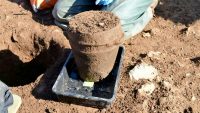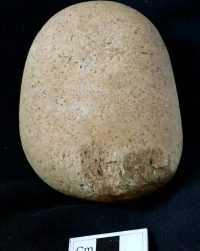 Archaeologists have discovered an intact 4,000-year-old cremation urn on a farm in Cornwall. Found less than 10 inches beneath the surface, the clay urn is unbroken and still contains ashes and what appear to be fragments of charred human bone.
Archaeologists have discovered an intact 4,000-year-old cremation urn on a farm in Cornwall. Found less than 10 inches beneath the surface, the clay urn is unbroken and still contains ashes and what appear to be fragments of charred human bone.
The team, led by Australian National University (ANU) archaeologist Catherine Frieman, unearthed the earthenware vessel dating to the Bronze Age during a two-week dig in a field near the town of Looe. The farmers told them the site had been extensively cultivated when they were children and for generations before that, so nobody expected to find a great deal of intact archaeological material, much less an urn buried there 4,000 years ago that managed to duck untold decades of ploughing.
“We were so excited to find such a lot of archaeology on the site despite scores of generations of ploughing, but to find an intact clay urn buried 4,000 years ago just 25 centimetres beneath the surface is nothing short of a miracle,” said Dr Frieman.
This and other evidence from the site has led her to conclude there was most likely a large mound over the burial which existed from prehistory well into the middle ages protecting the centre of the barrow.
“This is a sealed, intact cremation so it has the potential to tell us a lot about the cremation rite as it was practiced 4,000 years ago. We also appear to have some identifiable fragments of bone among the cremated remains so we’ll potentially be able to tell a lot about the individual themselves,” she said.
“We’ll be able to say what gender they were, possibly their age, or an age range, and depending on the bone preservation we can conduct analyses to examine where they were from, what their diet was like, where this food was coming from and what they ate and drank as a child when their teeth were forming. This is a very beautiful, very complete burial, and we’re very excited,” she said.
 Other Bronze Age objects have been found in the dig: some pottery, small flint tools and two hammer stones that were used to chip flint flakes off larger pieces to shape and edge tools and weapons. A number of Bronze Age shipwrecks have been found off the coast of southeast Cornwall, so it seems this area was a well-trafficked trade route going back to prehistory.
Other Bronze Age objects have been found in the dig: some pottery, small flint tools and two hammer stones that were used to chip flint flakes off larger pieces to shape and edge tools and weapons. A number of Bronze Age shipwrecks have been found off the coast of southeast Cornwall, so it seems this area was a well-trafficked trade route going back to prehistory.
The analysis of soil, pollen, flint and other samples is underway but it will probably be a year before a comprehensive story of the find is possible.
Is that mentioned site nearer to East Looe or nearer to West Looe? Or, is it the hill in between East Looe River and West Looe River? Myself, I only made it to Plymouth ages ago, but the Looe area likewise seems to be a really interesting spot.
On the second picture, there are “pits” being dug in a slight ‘slope’ or circle, possibly around what had been the ‘original’ barrow. As there are -as far as I could tell- indeed often secondary burials around more ancient mounds, I wonder if that is the case here.
:hattip:
———-
“It has been claimed that tin was first mined in Europe around 2500 BC in Erzgebirge, and knowledge of tin bronze and tin extraction techniques spread from there to Brittany and Cornwall around 2000 BC and from northwestern Europe to northwestern Spain and Portugal around the same time (Penhallurick 1986, p. 93). However, the only Bronze Age object from Central Europe whose tin has been scientifically provenanced is the Nebra sky disk, and its tin (and gold, though not its copper), is shown by tin isotopes to have come from Cornwall (Haustein, Gillis & Pernicka 2010). In addition, a rare find of a pure tin ingot in Scandinavia was provenanced to Cornwall (Ling et al. 2014). Available evidence, though very limited, thus points to Cornwall as the sole early source of tin in Central and Northern Europe.”
—-
In ‘Bibliotheca historica’ (1st century BC), Diodorus of Sicily (Διόδωρος Σικελιώτης, Siculus) described ancient tin mining in Britain:
“The ones that inhabit the British promontory of Belerion, by reason of their converse with strangers, are more civilised and courteous to strangers than the rest are. These are the people that prepare the tin, which with a great deal of care and labour, they dig out of the ground, and that being done the metal is mixed with some veins of earth out of which they melt the metal and refine it. Then they cast it into regular blocks and carry it to a certain island near at hand called Ictis for at low tide, all being dry between there and the island, tin in large quantities is brought over in carts. [] Then, the merchants buy the tin from the natives and carry it over to Gaul, and after travelling overland for about thirty days, they finally bring their loads on horses to the mouth of the Rhone.”
What route would take thirty days to the mouth of the Rhone? Through the Carcassonne gap?
Would they first have used boats up the Garonne? Is there an obvious head of navigation on that river for this purpose? Toulouse?
I presume there were several routes over a time span of 2000 years, and to go via Toulouse might have been an option. My personal guess, however, would be ‘Belgica’, the Low Countries, the Rhine valley, or, the route via the “Parisii” (Seine).
There were ‘roads’ before the Roman invasion, and if you have a look at where important ‘oppida’ are, you might have already a hint for the route into the Rhone valley. The deal could have been to bring wine from Italy up the Rhone and take tin on your way back.
Ah, the route from Toulouse to Looe!